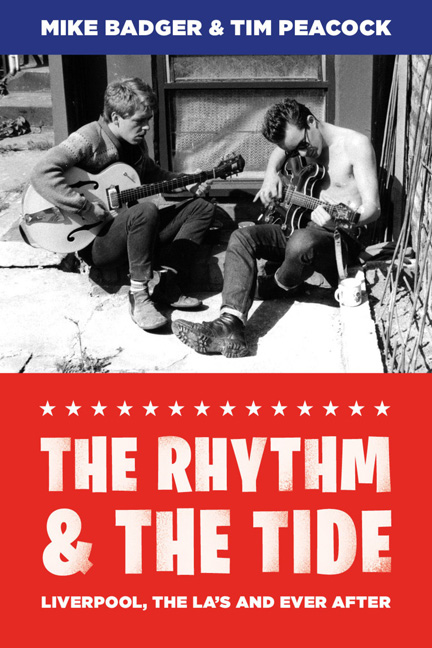Book contents
- Frontmatter
- Contents
- Dedication
- Author's Preface
- 1 Huyton (Two Dogs Fightin' – A Black and a White'n)
- 2 Eric's and Post-Punk Liverpool
- 3 The Smile that You Send Out Returns to You
- 4 The Kindergarten Paint Set
- 5 A Secret Liverpool
- 6 The La's: Breakloose!
- 7 We Have Lift Off!
- 8 The Onset: A New Beginning
- 9 Tumbledown Garage Rock Eclecticism
- 10 Tin Can Alley
- 11 It's a Long Way Back to Germany
- 12 Seeds
- 13 The Pool of Life Revisited
- 14 One Man's Fish is a French Man's Poisson
- 15 Tin Planet
- 16 Lost in Space
- 17 La, a Note to Follow So
- 18 Freedom Now
- 19 Double Zero
- 20 In a Viper Style
- 21 Callin’ All: Lost La's 1986–1987
- 22 Growing Up Is a Killer
- 23 New York State of Mind
- 24 More Unearthing
- 25 Shangri-La
- Roll Call
- Where to See Mike Badger's Art
- Discography
- Art Biography
- Index
- Plate section
14 - One Man's Fish is a French Man's Poisson
- Frontmatter
- Contents
- Dedication
- Author's Preface
- 1 Huyton (Two Dogs Fightin' – A Black and a White'n)
- 2 Eric's and Post-Punk Liverpool
- 3 The Smile that You Send Out Returns to You
- 4 The Kindergarten Paint Set
- 5 A Secret Liverpool
- 6 The La's: Breakloose!
- 7 We Have Lift Off!
- 8 The Onset: A New Beginning
- 9 Tumbledown Garage Rock Eclecticism
- 10 Tin Can Alley
- 11 It's a Long Way Back to Germany
- 12 Seeds
- 13 The Pool of Life Revisited
- 14 One Man's Fish is a French Man's Poisson
- 15 Tin Planet
- 16 Lost in Space
- 17 La, a Note to Follow So
- 18 Freedom Now
- 19 Double Zero
- 20 In a Viper Style
- 21 Callin’ All: Lost La's 1986–1987
- 22 Growing Up Is a Killer
- 23 New York State of Mind
- 24 More Unearthing
- 25 Shangri-La
- Roll Call
- Where to See Mike Badger's Art
- Discography
- Art Biography
- Index
- Plate section
Summary
I'D INTENDED TO MAKE up a booklet to showcase my tin creations for a while and in June 1995 I finally got around to it, heading into Liverpool to purchase some slide films to photograph everything I'd made that was still in the house. It proved to be great fun to photograph and compile and I was very proud of the end result. I didn't know it at the time, but the booklet would end up playing a big part in getting me my first one-man show at Warrington Museum in 1997.
My fledgling sculpting career suddenly got a welcome boost when, from nowhere, the British Craft Room at Liberty of London got in touch asking me to make them a tin clock. Well, maybe it wasn't entirely out of the blue. A while before, a friend of ours, Joanne Irvine, asked me if I'd sent any slides of my tinwork to Liberty. She'd told me that if they accepted you then it could open doors, so I sent Liberty a brochure I'd had made of my sculptures at local design company Nonconform. To my surprise, they not only got back in touch, but asked me to make the clock for a show they were doing based around the concept of ‘time’.
It was an interesting project, so I headed into Liverpool in search of the right metal for the job. After a bit of searching, I found a perfect old tin in Quiggins and went home. I completed the clock by adding a found clock face I'd had for a while onto the hinged lid of the tin, then stuck the mechanism through and attached the fingers. It looked like a mantelpiece clock, but I was happy with it, even if it did have a surreal presence of its own. It looked like it was from Alice in Wonderland to me.
In Oct 1995 we rented a house in Addingham Road, Allerton. I'd managed to keep on the room below our flat on Aigburth Road, ostensibly as a studio for my art and sculpture, but also for its qualities as a potential rehearsal space. That space in Aigburth had been our home for years and a hotbed of creativity for both The La's and The Onset.
- Type
- Chapter
- Information
- The Rhythm and the TideLiverpool, The La's and Ever After, pp. 137 - 141Publisher: Liverpool University PressPrint publication year: 2015



